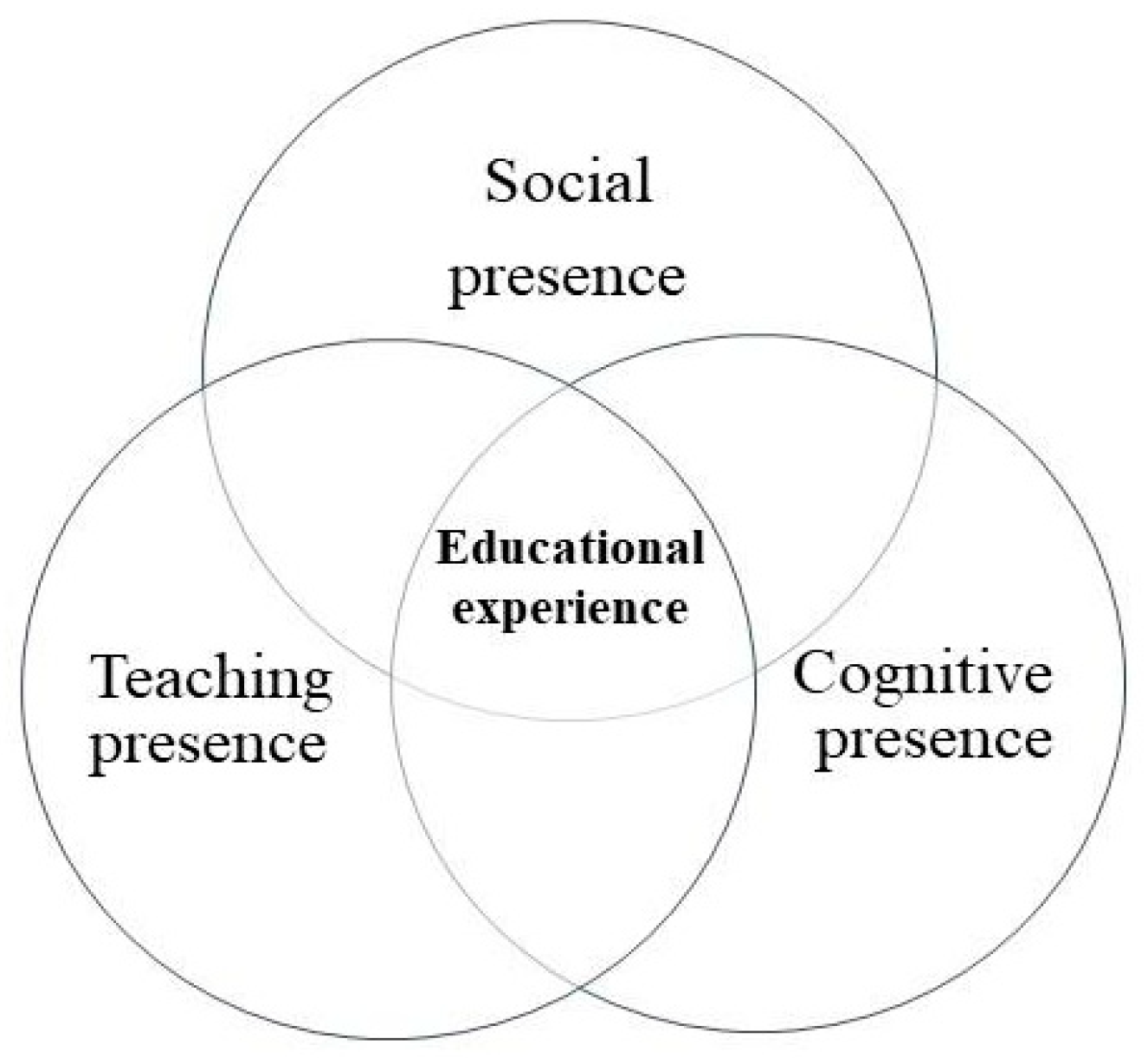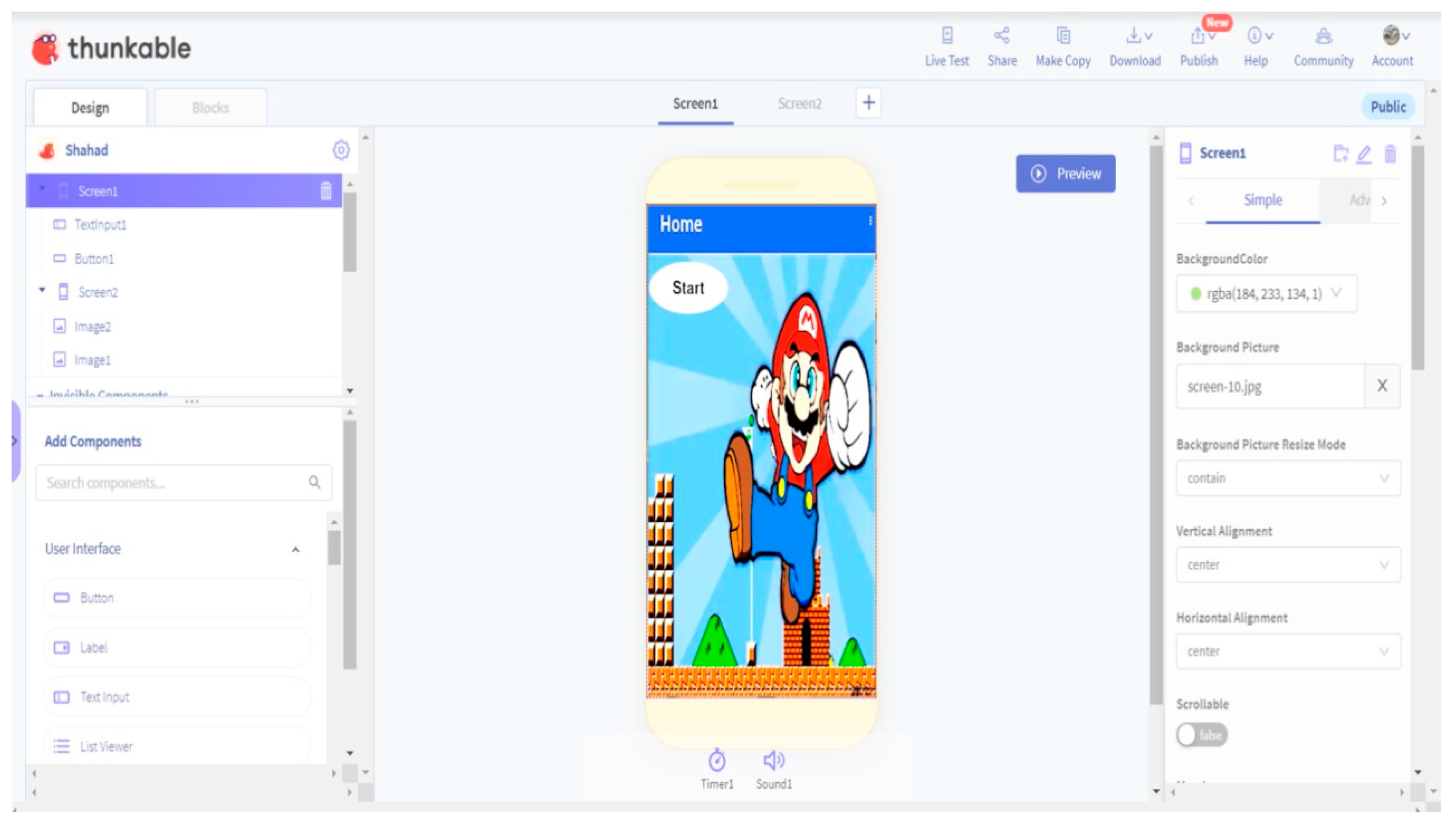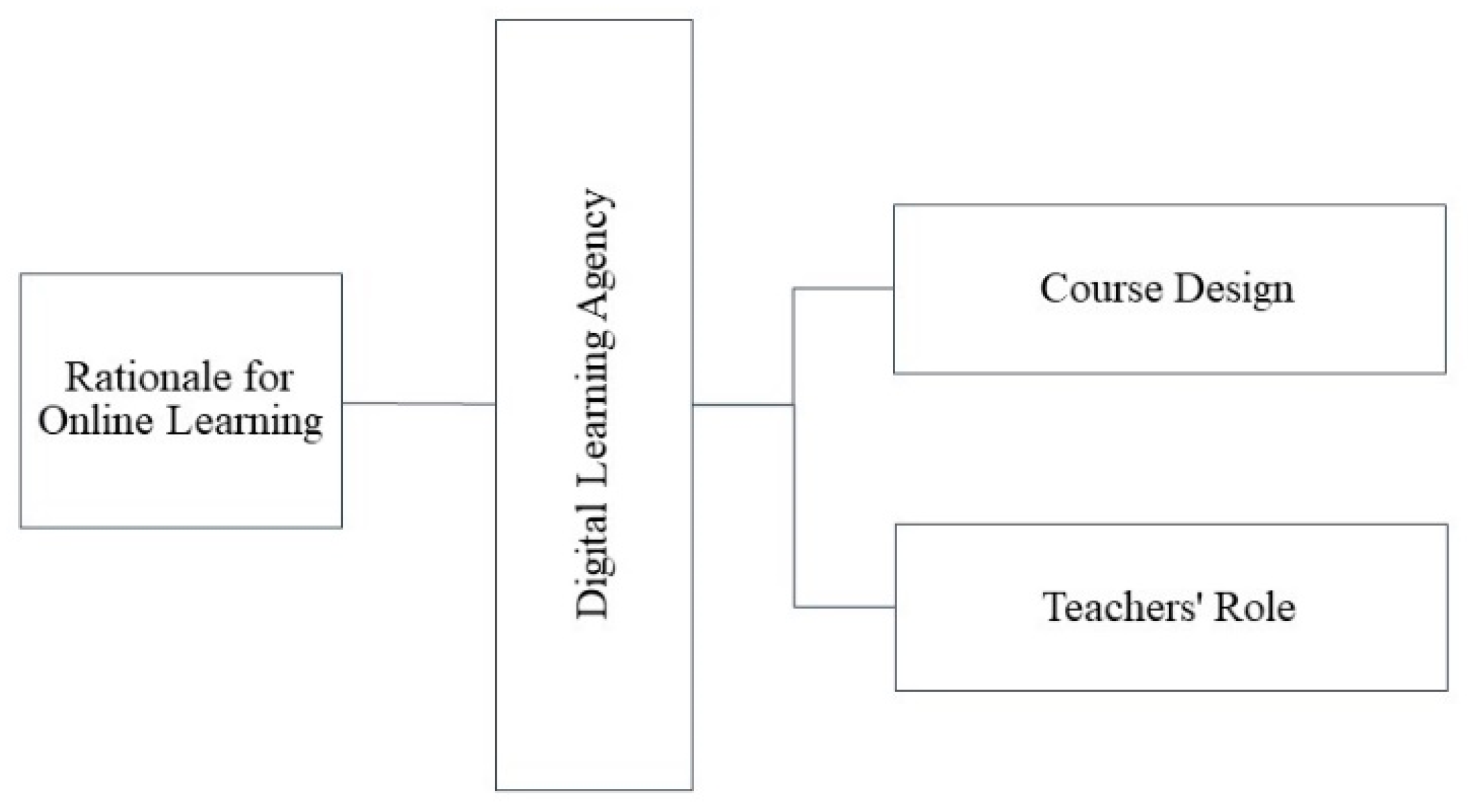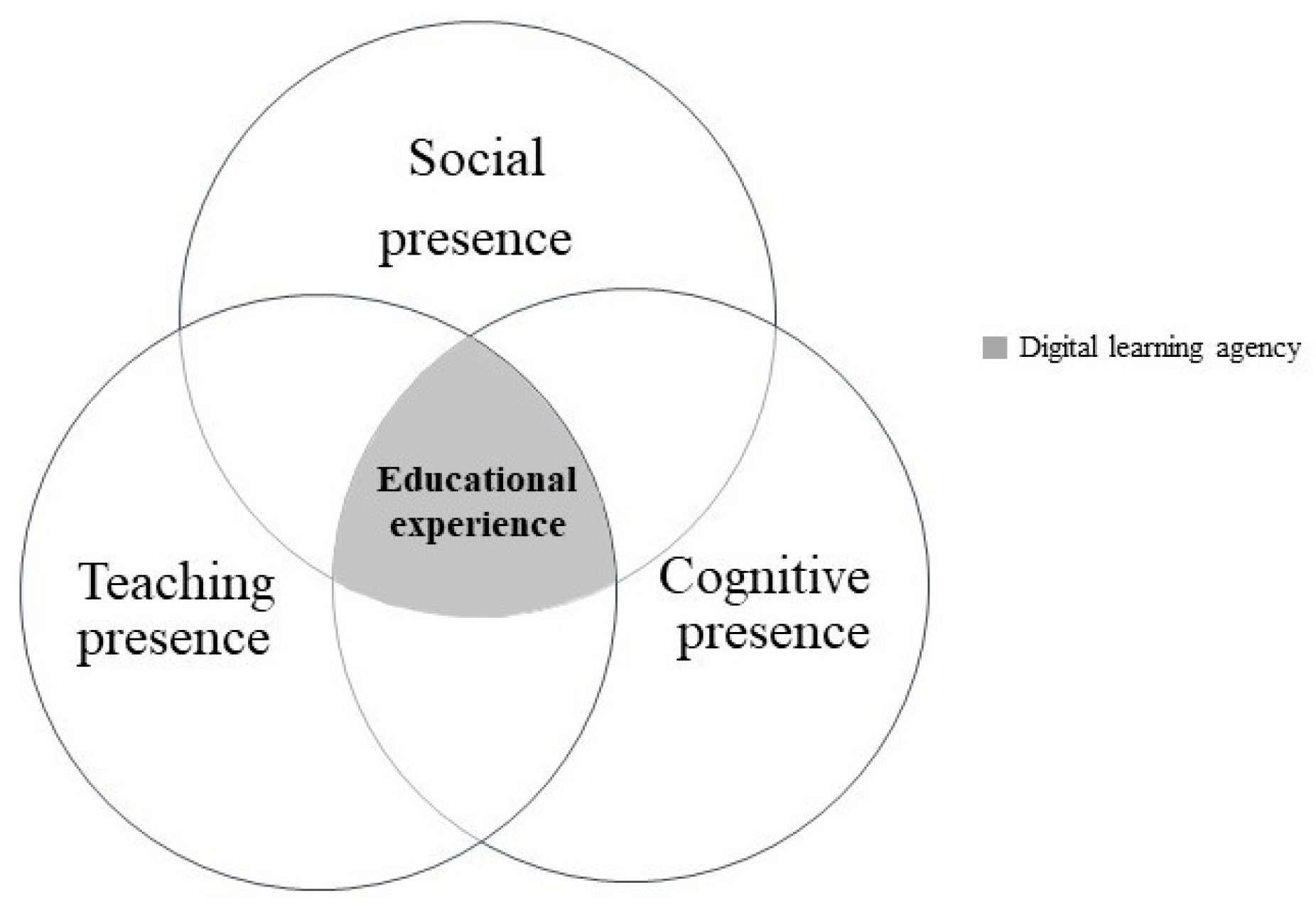Experiences of Middle School Programming in an Online Learning Environment
Abstract
1. Introduction
1.1. Context for the Study
1.2. Online Learning in Schools
2. Designing the Learning Experiences
The Online Learning Environment
3. Research Methodology
- What is the rationale for enrollment in online programming courses?
- What are the main influencing factors to learn programming effectively as an online experience?
3.1. Research Design
3.2. Participants
3.3. Data Collection Methods
3.4. Ethical Consideration
3.5. Data Analysis
4. Findings and Discussion
4.1. Rationale for the Online Programming Course
4.2. Factors Influencing the Effectiveness of Online Programming Learning
4.3. Course Design
4.4. Teacher’s Role
4.5. Digital Learning Agency
5. Conclusions
Author Contributions
Funding
Institutional Review Board Statement
Informed Consent Statement
Data Availability Statement
Acknowledgments
Conflicts of Interest
References
- Singh, V.; Thurman, A. How many ways can we define online learning? A systematic literature review of definitions of online learning (1988–2018). Am. J. Distance Educ. 2019, 33, 289–306. [Google Scholar] [CrossRef]
- Borup, J.; Chambers, C.; Stimson, R. Michigan Virtual University. Helping Online Students Be Successful: Student Perceptions of Online Teacher and On-Site Mentor Facilitation Support. Available online: https://mvlri.org/research/publications/helping-online-students-be-successful-student-perceptions-of-support/ (accessed on 6 October 2019).
- Huh, Y.; Reigeluth, C.M. Online K-12 teachers’ perceptions and practices of supporting self-regulated learning. J. Educ. Comput. Res. 2018, 55, 1129–1153. [Google Scholar] [CrossRef]
- Hart, C.; Berger, D.; Jacob, B.; Loeb, S.; Hill, M. Online Learning, Offline Outcomes: Online Course Taking and High School Student Performance. Aera Open 2019, 5, 1–17. [Google Scholar] [CrossRef]
- Harvey, D.; Greer, D.; Basham, J.; Hu, B. From the Student Perspective: Experiences of Middle and High School Students in Online Learning. Am. J. Distance Educ. 2014, 28, 14–26. [Google Scholar] [CrossRef]
- Garrison, D.R.; Anderson, T.; Archer, W. The first decade of the community of inquiry framework: A retrospective. Internet High. Educ. 2010, 13, 5–9. [Google Scholar] [CrossRef]
- Akyol, Z.; Garrison, D.R. The Development of a Community of Inquiry Over Time in an Online Course: Understanding the Progression and Integration of Social, Cognitive and Teaching Presence. J. Asynchron. Learn. Netw. 2008, 12, 3–22. [Google Scholar]
- Grover, S.; Pea, R.; Cooper, S. Designing for deeper learning in a blended computer science course for middle school students. Comput. Sci. Educ. 2015, 25, 199–237. [Google Scholar] [CrossRef]
- Higashi, R.M.; Schunn, C.D.; Flot, J.B. Different Underlying Motivations and Abilities Predict Student versus Teacher Persistence in an Online Course. Educ. Technol. Res. Dev. 2017, 65, 1471–1493. [Google Scholar] [CrossRef]
- Settle, A.; Vihavainen, A.; Miller, C.S. Research directions for teaching programming online. In Proceedings of the International Conference on Frontiers in Education: Computer Science and Computer Engineering, Las Vegas, NV, USA, 21–24 July 2014. [Google Scholar]
- Students at the Center Series. Motivation, Engagement, and Student Voice. Available online: http://studentsatthecenterhub.org/wpcontent/uploads/2012/04/Exec-Toshalis-Nakkula-032312.pdf (accessed on 13 January 2020).
- Webb, M.; Bottino, R.M.; Passey, D.; Kalas, I.; Bescherer, C.; Smith, J.M.; Fuschek, G. Coding, programming, and the changing curriculum for computing in schools. In Proceedings of the Report of UNESCO/IFIP TC3 Meeting at OCCE, Linz, Austria, 27 June 2019. [Google Scholar]
- Barbour, M.K.; Harrison, K.L. Teachers’ perceptions of K-12 online: Impacting the design of a graduate course curriculum. J. Educ. Technol. Syst. 2016, 45, 74–92. [Google Scholar] [CrossRef]
- Hendrix, N.; Degner, K. Supporting online AP students: The rural facilitator and considerations for training. Am. J. Distance Educ. 2016, 30, 133–144. [Google Scholar] [CrossRef]
- Huang, R.H.; Liu, D.J.; Tlili, A.; Yang, J.F.; Wang, H.H. Handbook on Facilitating Flexible Learning during Educational Disruption: The Chinese Experience in Maintaining Undisrupted Learning in COVID-19 Outbreak; Smart Learning Institute of Beijing Normal University: Beijing, China, 2020. [Google Scholar]
- Moreno-León, J.; Robles, G.; Román-González, M. Code to learn: Where does it belong in the K-12 curriculum? JITE Res. 2016, 15, 283–303. [Google Scholar] [CrossRef]
- Szabo, C.; Sheard, J.; Luxton-Reilly, A.; Simon, B.; Becker, B.A.; Ott, L. Fifteen years of introductory programming in schools: A global overview of K-12 initiatives. In Proceedings of the 19th Koli Calling International Conference on Computing Education Research, Koli, Finland, 21–24 November 2019. [Google Scholar]
- Boyer, N.R.; Langevin, S.; Gaspar, A. Self-direction and constructivism in programming education. In Proceedings of the 9th ACM SIGITE conference on Information Technology education (SIGITE 2008), Cincinnati, OH, USA, 16–18 October 2008. [Google Scholar]
- Popat, S.; Starkey, L. Learning to code or coding to learn? A systematic review. Comput. Educ. 2019, 128, 365–376. [Google Scholar] [CrossRef]
- Denner, J.; Werner, L.; Ortiz, E. Computer games created by middle school girls: Can they be used to measure understanding of computer science concepts? Comput. Educ. 2012, 58, 240–249. [Google Scholar] [CrossRef]
- Hiltunen, T. Learning and teaching programming skills in Finnish Primary Schools–the potential of games. Master’s Thesis, Department of Information Processing Science, University of Oulu, Oulu, Finland, 2016. [Google Scholar]
- Tsay, C.H.; Kofinas, A.; Luo, J. Enhancing student learning experience with technology-mediated gamification: An empirical study. Comput. Educ. 2018, 121, 1–17. [Google Scholar] [CrossRef]
- Pilkington, C. A playful approach to fostering motivation in a distance education computer programming course: Behaviour change and student perceptions. Int. Rev. Res. Open Distrib. Learn. 2018, 19, 282–298. [Google Scholar] [CrossRef]
- Dicheva, D.; Dichev, C.; Agre, G.; Angelova, G. Gamification in education: A systematic mapping study. Educ. Technol. Soc. 2015, 18, 75–88. [Google Scholar]
- Putz, L.M.; Hofbauer, F.; Treiblmaier, H. Can gamification help to improve education? Findings from a longitudinal study. Comput. Hum. Behav. 2020, 110, 106392. [Google Scholar] [CrossRef]
- Piteira, M.; Costa, C.; Aparicio, M. Computer programming learning: How to apply gamification on online courses? J. Inf. Syst. Eng. Manag. 2018, 3, 11. [Google Scholar] [CrossRef]
- Azmi, S.; Iahad, N.; Ahmad, N. Attracting Students’ Engagement in Programming Courses with Gamification. In Proceedings of the 2016 IEEE Conference on e-Learning, e-Management and e-Services (IC3e), Langkawi, Malaysia, 10–12 October 2016. [Google Scholar]
- Utomo, A.Y.; Santoso, H.B. Development of gamification-enriched pedagogical agent for e-learning system based on community of inquiry. In Proceedings of the International HCI and UX Conference in Indonesia, Depok, Indonesia, 8 April 2015. [Google Scholar]
- Anfara, V.A.; Mertz, N.T. Theoretical Frameworks in Qualitative Research, 2nd ed.; SAGE: Thousand Oaks, CA, USA, 2006. [Google Scholar]
- Garrison, D.R. Communities of inquiry in online learning. In Encyclopedia of Distance Learning, 2nd ed.; Rogers, P., Ed.; IGI Global: Hershey, PA, USA, 2009; pp. 352–355. [Google Scholar]
- Bektashi, L. Community of Inquiry Framework in Online Learning: Use of Technology. In Technology and the Curriculum: Summer 2018; ebook; Power, P., Surrey, B.C., Eds.; Power Learning Solutions: Sydney, NS, Canada, 2018; pp. 147–160. [Google Scholar]
- Garrison, D.R. E-learning in the 21st Century: A Community of Inquiry Framework for Research and Practice, 3rd ed.; Taylor & Francis: Routledge, UK, 2017. [Google Scholar]
- Common Sense Education. Websites Review: Thunkable. Available online: https://www.commonsense.org/education/website/thunkable (accessed on 21 January 2018).
- Quality Matters. K-12 Rubric Workbook Standards for Course Design (5th ed). Available online: https://www.qualitymatters.org/qa-resources/rubric-standards/k-12-secondary-rubric (accessed on 9 January 2020).
- Barbour, M.K.; Clark, T.; DeBruler, K.; Bruno, J. Evaluation and Approval Constructs for Online and Blended Courses and Providers; Michigan Virtual Learning Research Institute at MVU: Lansing, MI, USA, 2014; Available online: http://media.mivu.org/institute/pdf/eval_constructs.pdf (accessed on 21 January 2018).
- Creswell, J.W. Research Design: Qualitative, Quantitative and Mixed Method Approaches, 3rd ed.; SAGE: Thousand Oaks, CA, USA, 2009. [Google Scholar]
- Hour of Code. Code.org. Available online: https://hourofcode.com/uk/events/2015/sa (accessed on 7 January 2021).
- Lincoln, Y.S.; Guba, E.G. Naturalistic Inquiry; SAGE: Thousand Oaks, CA, USA, 1985. [Google Scholar]
- Lowes, S.; Lin, P. Learning to learn online: Using locus of control to help students become successful online learners. J. Online Learn. Res. 2015, 1, 17–48. [Google Scholar]
- Kanuka, H.; Garrison, D.R. Cognitive presence in online learning. J. Comput. High. Educ. 2004, 15, 21–39. [Google Scholar] [CrossRef]
- Su, C.H.; Cheng, C.H. A mobile gamification learning system for improving the learning motivation and achievements. J. Comput. Assist. Learn. 2015, 31, 268–286. [Google Scholar] [CrossRef]
- Combéfis, S.; Beresnevičius, G.; Dagienė, V. Learning programming through games and contests: Overview, characterisation and discussion. Olymp. Inform. 2016, 10, 39–60. [Google Scholar] [CrossRef]
- Özhan, S.C.; Kocadere, S.A. The effects of flow, emotional engagement, and motivation on success in a gamified online learning environment. J. Educ. Comput. Res. 2020, 57, 2006–2031. [Google Scholar] [CrossRef]
- Johnson, C. Learning basic programming concepts with game maker. Int. J. Comput. Sci. Educ. Sch. 2017, 1, n2. [Google Scholar]
- Garrison, D.R. Online Community of Inquiry Review: Social, Cognitive, and Teaching Presence Issues. J. Asynchronous Learn. Netw. 2007, 11, 61–72. [Google Scholar] [CrossRef]
- Lin, C.H.; Zheng, B.; Zhang, Y. Interactions and learning outcomes in online language courses. Br. J. Educ. Technol. 2017, 48, 730–748. [Google Scholar] [CrossRef]
- Fessakis, G.; Gouli, E.; Mavroudi, E. Problem solving by 5–6 years old kindergarten children in a computer programming environment: A case study. Comput. Educ. 2013, 63, 87–97. [Google Scholar] [CrossRef]
- Passey, D.; Shonfeld, M.; Appleby, L.; Judge, M.; Saito, T.; Smits, A. Digital agency: Empowering equity in and through education. Technol. Knowl. Learn. 2018, 23, 425–439. [Google Scholar] [CrossRef]
- Martin, J. Self-regulated learning, social cognitive theory, and agency. Educ. Psychol. 2004, 39, 135–145. [Google Scholar] [CrossRef]
- Zeiser, K.; Scholz, C.; Cirks, V. Maximizing Student Agency Implementing and Measuring Student-Centered Learning Practices; American Institutes for Research: Washington, DC, USA, 2018. [Google Scholar]
- Israel-Fishelson, R.; Hershkovitz, A. Persistence in a game-based learning environment: The case of elementary school students learning computational thinking. J. Educ. Comput. Res. 2020, 58, 891–918. [Google Scholar] [CrossRef]
- Amos, C.; Copeland, T.; Fidow, S.; Langford, D.; Newton, C.; Newton, C.; Ohia, R.; O’Riley, B.; Shevland, K.; Sutherland, S.; et al. Future-Focused Learning in Connected Communities. A Report by the 21st Century Learning Reference Group: New Zeland. 2014. Available online: http://www.education.govt.nz/assets/Documents/Ministry/Initiatives/FutureFocusedLearning30May2014.pdf (accessed on 9 January 2020).
- Learner Agency, Strategies to Develop Student Agency. Core Education. Available online: https://core-ed.org/en_NZ/free-resources/ten-trends/2017-ten-trends/learner-agency/ (accessed on 7 January 2021).
- Armellini, A.; De Stefani, M. Social presence in the 21st century: An adjustment to the Community of Inquiry framework. Br. J. Educ. Technol. 2016, 47, 1202–1216. [Google Scholar] [CrossRef]
- Zdawczyk, C.; Varma, K. Engaging girls in computer science: Gender differences in attitudes and beliefs about learning scratch and python. Comput. Sci. Educ. 2022, 1, 1–21. [Google Scholar] [CrossRef]
- Reimers, F.; Schleicher, A.; Saavedra, J.; Tuominen, S. Supporting the Continuation of Teaching and Learning during the COVID-19 Pandemic, Organization for Economic Co-Operation and Development (OECD). 2020. Available online: http://www.oecd.org/education/Supporting-the-continuation-of-teaching-and-learning-during-the-COVID-19-pandemic.pdf (accessed on 11 June 2021).
- Xu, H.; Ge, S.; Yuan, F. Research on the Mechanism of Influence of Game Competition Mode on Online Learning Performance. Behav. Sci. 2022, 12, 225. [Google Scholar] [CrossRef] [PubMed]
- Xu, Z.; Ritzhaupt, A.D.; Tian, F.; Umapathy, K. Block-based versus text-based programming environments on novice student learning outcomes: A meta-analysis study. Comput. Sci. Educ. 2019, 29, 177–204. [Google Scholar] [CrossRef]





| Online Programming Course | ||
|---|---|---|
| Platform | TalentLMS (Learning Platform) | Thunkable (Programming Platform) |
| Objective | students used this platform to learn and communicate | students used this platform to build their own game |
| Description | TalentLMS offers:
| Thunkable offers:
|
| Themes | Sub-Themes | Quotes/Data |
|---|---|---|
| Rationale for Online Learning (social presence & cognitive presence) | flexibility | It is easier [the course], I can access it any time (student’s interview). An advantage of the online course for the students is the availability of accessing the materials on their convenience (teacher’s interview). |
| problem-solving skills | I will benefit from learning programming. When I face problems, I will be able to solve them. Also having a certificate will make me better than others (focus group). | |
| time investment | It is enjoyable, and it is better than wasting my time in watching episodes (focus group). | |
| passion to learn programming | Get benefits and have a new experience and learn about programming (student’s interview). | |
| planning future careers | Probably I will pursue game design in the future (student’s interview). | |
| Teacher’s role (Teaching presence) | orientation | Having a live orientation meeting in the beginning of the course would address the main challenges facing the students (teacher’s diary). |
| timely support | Students expect timely responses to their inquiries. I think timely responses increase students’ enthusiasm for learning and their progress (teacher’s interview). | |
| encouragement | I noticed that using encouraging words has assisted to increase students’ motivation to keep on progress, earn badges, and compete with their peers (teacher’s interview). | |
| Course design (Social presence, cognitive presence & teaching presence) | virtual meeting | The live sessions helped me understand the difficulties that I met in accessing the link to Thunkable (student’s interview). |
| guidelines and support | This course offers guidelines and support from the teacher as well as enabling me to practice (student’s interview). | |
| gamification | Online learning has great advantages. It is enjoyable and interesting when it includes competitions (focus group). | |
| content | I like to watch the videos to practice without missing any step (student’s interview). | |
| game development | The course enabled me to learn enjoyable things I have learned how to develop a game I learn the fundamental issues in programming with fun as I made a game and played with it (student’s interview). | |
| Digital learning agency (Digital confidence, digital competence & digital accountability) | technological issues | No reports of any login difficulties or problems with their TalentLMS accounts or the Thunkable platform (content analysis). Access was via laptop and mobile devices (focus group). |
| student-led instruction | Self-learning skills (system’s student progress report) | |
| live collaboration preference | Students supported each other (collaborative online learning) during the live sessions (teacher’ diary). This (experience) simplified many steps as we helped each other when working at the same time (focus group). | |
| responsibility | Concern about future careers and maintaining family privacy (focus group). |
Publisher’s Note: MDPI stays neutral with regard to jurisdictional claims in published maps and institutional affiliations. |
© 2022 by the authors. Licensee MDPI, Basel, Switzerland. This article is an open access article distributed under the terms and conditions of the Creative Commons Attribution (CC BY) license (https://creativecommons.org/licenses/by/4.0/).
Share and Cite
Alebaikan, R.; Alajlan, H.; Almassaad, A.; Alshamri, N.; Bain, Y. Experiences of Middle School Programming in an Online Learning Environment. Behav. Sci. 2022, 12, 466. https://doi.org/10.3390/bs12110466
Alebaikan R, Alajlan H, Almassaad A, Alshamri N, Bain Y. Experiences of Middle School Programming in an Online Learning Environment. Behavioral Sciences. 2022; 12(11):466. https://doi.org/10.3390/bs12110466
Chicago/Turabian StyleAlebaikan, Reem, Hayat Alajlan, Ahmad Almassaad, Norah Alshamri, and Yvonne Bain. 2022. "Experiences of Middle School Programming in an Online Learning Environment" Behavioral Sciences 12, no. 11: 466. https://doi.org/10.3390/bs12110466
APA StyleAlebaikan, R., Alajlan, H., Almassaad, A., Alshamri, N., & Bain, Y. (2022). Experiences of Middle School Programming in an Online Learning Environment. Behavioral Sciences, 12(11), 466. https://doi.org/10.3390/bs12110466






